Nos. 19 thru 25 represent infantry colors belonging to regiments from the province of Friesland.
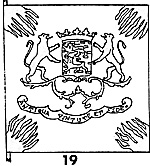 19. Described as taken at Brussels in February
1746. The only Friesland regiment in garrison was IR Ayalva. This is probably
the Principal Color of that regiment. A white field with gold corner flames.
In the center the boat-of-arms of Friesland: a blue shield with two golden
lions and bars; two golden lions as supporters and a gold crown lined red.
The design beneath the coat-of-arms is also gold. The ribbon is blue with
the inscription ANTIQUA VIRTUTE ET FIDE in gold.
19. Described as taken at Brussels in February
1746. The only Friesland regiment in garrison was IR Ayalva. This is probably
the Principal Color of that regiment. A white field with gold corner flames.
In the center the boat-of-arms of Friesland: a blue shield with two golden
lions and bars; two golden lions as supporters and a gold crown lined red.
The design beneath the coat-of-arms is also gold. The ribbon is blue with
the inscription ANTIQUA VIRTUTE ET FIDE in gold.
20.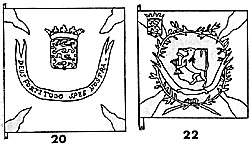 Taken at Brussels in February 1746. Probably
the Second Color of IR Ayalva. A red Field with white corner flames. In
the center the coat-of-arms of Friesland (see No. 19). A blue ribbon with the inscription DEUS FORTITUDO SPES NOSTRA
in gold. The remaining five colors can not with certainty be attributed
to any particular regiments; however, two Friesland regiments probably
lost their colors when the cities in which they were part of the garrison
surrendered to the French: Schwartzenberg (Mons, July 1746) and Glinstra
(Namur, October 1747). This would account for four of the Five. The fifth
might possible have been lost during the Battle of Rocour in October 1747
where two Friesland regiments were present: Lippe and Burmania.
Taken at Brussels in February 1746. Probably
the Second Color of IR Ayalva. A red Field with white corner flames. In
the center the coat-of-arms of Friesland (see No. 19). A blue ribbon with the inscription DEUS FORTITUDO SPES NOSTRA
in gold. The remaining five colors can not with certainty be attributed
to any particular regiments; however, two Friesland regiments probably
lost their colors when the cities in which they were part of the garrison
surrendered to the French: Schwartzenberg (Mons, July 1746) and Glinstra
(Namur, October 1747). This would account for four of the Five. The fifth
might possible have been lost during the Battle of Rocour in October 1747
where two Friesland regiments were present: Lippe and Burmania.
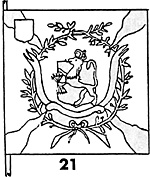 21. Possible a Principal Color. A white Field
with light red corner flames. In the upper, inner corner a blue shield
(possibly unfinished coat-of-arms of Friesland, the only province with
blue as a background color.) In the center the outline of a shield in gold.
In front of the shield a crowned, golden lion holding a sheaf of arrows
also in gold. A blue ribbon without inscription. The wreath in gold tied
with a blue ribbon.
21. Possible a Principal Color. A white Field
with light red corner flames. In the upper, inner corner a blue shield
(possibly unfinished coat-of-arms of Friesland, the only province with
blue as a background color.) In the center the outline of a shield in gold.
In front of the shield a crowned, golden lion holding a sheaf of arrows
also in gold. A blue ribbon without inscription. The wreath in gold tied
with a blue ribbon.
22. Possible the Second Color of the same regiment as No. 20. A red field with white corner flames, In the upper, inner corner the coat-of-arms of Friesland (see No. 19). In the center die outline of a shield in gold. In front an uncrowned, gold lion holding a sheaf of arrows. A white ribbon without inscription. The wreath in gold tied with a blue ribbon.
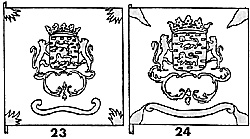 23. Possibly a Second Color. A blue field with gold corner flames. In the center the coat-of-arms of Friesland (see No. 19) supported by two gold lions and surmounted by a golden crown lined red with red and blue jewels in its base. The design under die coat-of-arms in gold. A blue ribbon without inscription.
23. Possibly a Second Color. A blue field with gold corner flames. In the center the coat-of-arms of Friesland (see No. 19) supported by two gold lions and surmounted by a golden crown lined red with red and blue jewels in its base. The design under die coat-of-arms in gold. A blue ribbon without inscription.
24. Possibly a Principal Color. A white Field with red corner flames. In the center the coat-of-arms of Friesland (see No. 19) supported by two gold lions and surmounted by a gold crown lined red with blue and red jewels in its base. Under the coat-of-arms a gold design, and a blue ribbon without inscriptions field with red corner flames. In the center the coat-of-arms of Friesland (see No. 19) supported by two gold lions and surmounted by a gold crown lined red with blue and red jewels in its base. Under the coat-of-arms a gold design, and a blue ribbon without inscription.
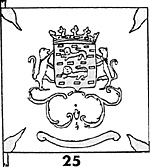 No. 25. Possibly the Second Color of the same regiment as No. 24. A red field with white field with red corner flames. In the center the coat-of-arms of Friesland (see No. 19) supported by two gold lions and surmounted by a gold crown lined red with blue and red jewels in its base. Below the coat-of-arms a gold design, and a blue ribbon without inscription.
No. 25. Possibly the Second Color of the same regiment as No. 24. A red field with white field with red corner flames. In the center the coat-of-arms of Friesland (see No. 19) supported by two gold lions and surmounted by a gold crown lined red with blue and red jewels in its base. Below the coat-of-arms a gold design, and a blue ribbon without inscription.
26. Possibly colors of the Oranje-Friesland. If so, they were probably taken at the Battle of Rocour in October 1746. A white field with orange corner flames. The coat-of-arms in the center are edged in gold. The larger shield is quartered; upper left a gold lion and bars on a blue Field, upper right a red lion on a gold field, lower right two gold lions on a red field, lower left a red field with a white center stripe. The next smaller shield is also quartered; upper left and lower right red field with a gold diagonal stripe, upper right and lower left a gold field with a blue horn. The smallest shield is gold with four blue bars forming a cross with the center point open revealing the gold field. The coat-of-arm is surrounded by a blue ribbon edged in gold. The lion supporters are gold with red tongues. The lions' crowns are gold lined red. The center crown is gold lined red with red and blue jewels on its base. The trophy of arms are the same on both sides beginning from the top; a red standard white cloth wreath. The finials of all standards are colors in the trophy are gold and the staffs are brown. The ribbon is blue without inscription. There is another color in the collection which is similar, but with a few differences. The color probably belongs to Oranje-Groningen and was taken at Mons in July 1746. First the smallest shield in the coat-of-arms is blue with the bars forming the cross in yellow. Second, the lion supporters are holding small, gold branches in their upper paws.
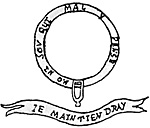 Third, the ribbon surrounding the coat-of-arms has the inscription HO NI SOI QUI MAL Y PENSE
in gold and the lower ribbon has the inscription (IE MAINTIENDRAY) in gold.
Fourth, the white cloth wreaths on the bottom blue flags are missing. The
colors for Oranje Gelderland may also have been similar to these.
Third, the ribbon surrounding the coat-of-arms has the inscription HO NI SOI QUI MAL Y PENSE
in gold and the lower ribbon has the inscription (IE MAINTIENDRAY) in gold.
Fourth, the white cloth wreaths on the bottom blue flags are missing. The
colors for Oranje Gelderland may also have been similar to these.
-
Dutch Colors in WAS Introduction
Dutch cavalry standards, dragoon guidons, Zeeland colors
Gederland colors, Utrecht standards
Overijssel colors
Back to Table of Contents -- Courier #63
Back to Courier List of Issues
Back to Master Magazine List
© Copyright 1993 by The Courier Publishing Company.
This article appears in MagWeb (Magazine Web) on the Internet World Wide Web.
Other military history articles and gaming articles are available at http://www.magweb.com